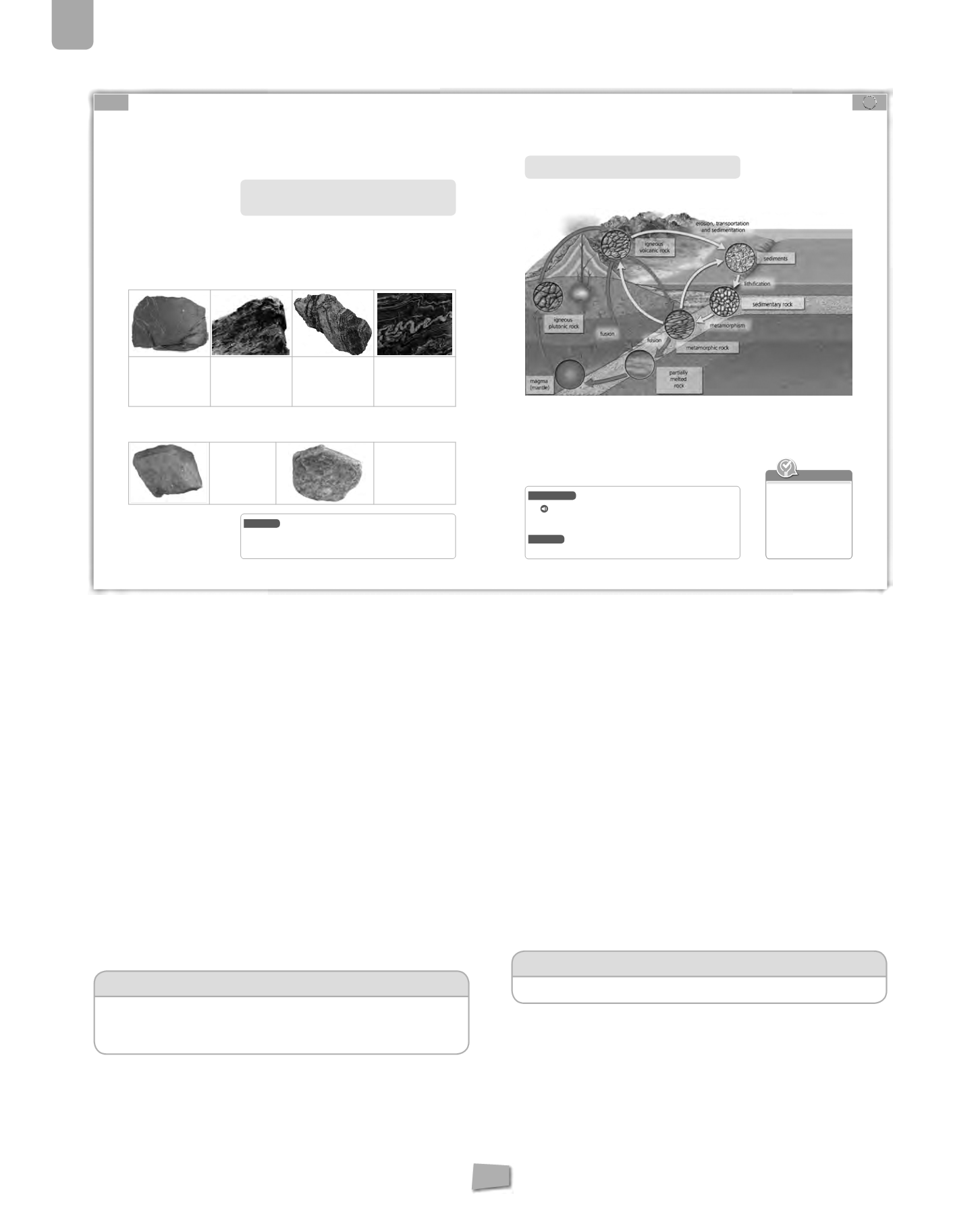
3
The Geosphere
116
3.3.
Metamorphic rocks
Metamorphic rocks originate from the transformation of other rocks
because of the increased pressure, high temperature or both. Those
factors act on the rocks that are placed in the interior of the Earth
and provoke a reshaping or a change in the composition of rocks,
changing them into a different type of rock.
To become a metamorphic rock, the rock cannot melt before its
formation. If the original rock melts, magma will form. Magma
can rise and cool under the crust, creating plutonic igneous rocks.
Magma can also come out of the crust to the exterior and solidify,
creating volcanic igneous rocks.
When you finish this section, it is important to highlight that rocks
are variable and are constantly changing, either because of external
agents or pressure increase or high temperatures. It causes a slow but
constant transformation on the rocks called the rock cycle.
Students could now do question 24. Before answering, they need
to review the section on igneous rocks in order to complete the task.
The science practical suggested on page 64 will clarify concepts of
this section.
Web page:
IDENTIFYING ROCKS
Short quiz to finish this section. There are different questions
about a photo. Students could make an identification key from
the questions and answers of the identified rocks.
3.4.
The rock cycle
Ask students:
How can rocks change into something different?
Tell them to read the text, look at the image and discuss the
process involved in rock transformation in pairs. Ask them:
Can
a metamorphic rock change directly into an igneous rock? For a
rock to be metamorphic, does it have to be a sedimentary rock
first?
Ask the students to close their books and then ask them to help
you draw the rock cycle on the board, step by step. Give cues
when necessary. The ask them to copy their own versions in their
notebooks.
Students could now do questions 25 to 27. For question 25,
p
P
lay the audio twice, the second time ask students to raise their
hands if they think the sentence is true. Before doing question 26
they should look at the diagram of the rock cycle once again. For
question 27, ask students to discuss this in small groups and to
come up with three simple explanations.
Finish this section reviewing the
Key concepts
on page 59.
Curricular adaptation:
6. THE ROCK CYCLE
Section adapted according to the curriculum.
58
59
3. Thegeosphere
3
+
www
3.3.
Metamorphic rocks
Rocks that are located deep in the crust are subjected to the pressure created by
the rocks above them. In addition, if these rocks are near magma, they are also
exposed to high temperatures. Pressure and high temperature causes changes in
the minerals that compose a rock and a new rock forms.
Metamorphic rocksare classifiedaccording to their texture, in twogroups: foliated
and non-foliated.
❚
In
foliated metamorphic rocks
the minerals are arranged to form parallel
layers. This layered structure is easily observed in many rocks of this type.
Foliated metamorphic rocks are identified from low to high grades of
metamorphism: slate, schist, gneiss and migmatite.
❚
In
non-foliated metamorphic rocks
the minerals are not arranged in layers.
The most common are marble and quartzite.
3.4.
The rock cycle
Any rock can be transformed into a different type of rock.
These processes occur very slowly, so the rock cycle takes place over millions of
years.
Key concepts
❚
Rocksareaggregatesof two
or various minerals.
❚
Accordingtotheirorigin,rocks
are classified into igneous or
magmatic, sedimentary, and
metamorphic.
❚
The process by which rocks
transform intodifferent rocks
is called the rock cycle.
The
rock cycle
is a series of processes that a rock goes through to transform
into another type of rock.
Slate
results from the
metamorphism of clay.
It is composed of small
crystals visible under the
microscope. Slate breaks into
thin sheets.
Schist
comes from clay,
afterahighermetamorphism
than in the caseof slate.
Its crystalsare visiblewithout
amicroscope.
Gneiss
originates from
detrital sedimentary rocks or
from granite. Its crystals are
bigger than those in schist.
They are arranged in wavy
bands.
Migmatite
are rocks half
way between igneous and
metamorphic rocks. They have
experienced a very intense
metamorphism that partially
melts the original rock.
Marble
originates
from the metamorphism
of limestone.
Its minerals are
transformed due
to exposure to high
temperatures.
Quartzite
originates from
the metamorphism of
sandstone. Like marble,
it forms due to the exposure
of the original rock to high
temperatures.
The rock cycle
❚
Metamorphism
is the process that changes a rock into a different type of
rock.
❚
Rocks that form in this way are called
metamorphic rocks
.
Analyse
24.
Comparethe igneousandmetamorphicrockprocesses.Whatconditions
are needed for a rock to transform into metamorphic rock and not
igneous when subjected to high temperatures?
Understand
25.
Listen, look at the rock cycle and say true or false.
26.
In which layer of the geosphere does the rock cycle take place? Which
rocks form at the deepest level?
Analyse
27.
Explain which types of rocks can transform into igneous rocks.
All rocks, exposed to the action of wind and water, can go undergo the processes
of erosion, transportation and sedimentation. Sediments deposited in sedimentary
basins undergo the process of diagenesis or lithification and are transformed into
sedimentary rocks
.
The rocks in the Earth’s crust are subjected to high pressures and/or temperatures
form
metamorphic rocks
. If the rocksmelt,magmawill form.Magmacan riseand
cool under the crust, creating
plutonic igneous rocks
. Magma can also come out
of the crust to the exterior and solidify, creating
volcanic igneous rocks
.


